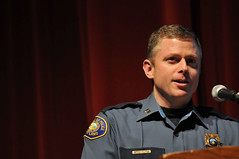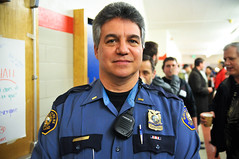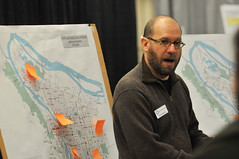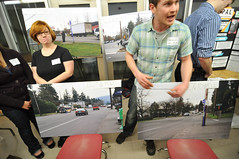
Mayor Adams with her big ideas.
– Full Gallery –
(Photos © J. Maus)
The City of Portland Bureau of Transportation and Mayor Sam Adams hosted the Transportation Safety Summit Tuesday night. The event brought together advocacy groups, city staffers, citizen activists, and leaders from PBOT, the Oregon Department of Transportation and other agencies. The goal was to share information, garner feedback, and get focused around our city’s top safety priorities.
The crowd was a who’s-who of citizen activism and advocacy in Portland, and the Summit gave them a golden opportunity to bend the ear of policymakers. But before the real work could get started, the crowd sat back and listened to presentations from six speakers; Mayor Sam Adams, outgoing PBOT Director Sue Keil, her replacement Tom Miller, Police Bureau Traffic Division Captain Todd Wyatt, ODOT Region 1 Manager Jason Tell, and TriMet General Manager Neil McFarlane.
Pointing out that more people have died on Portland’s roads in the past decade (around 364) than were sitting in the large auditorium, Adams said that he has made safety the #1 priority for Portland. “We’ve prioritized safety over smooth streets.” Adams also explained why safety matters — from the $100 million per year traffic crashes cause in health care costs and productivity losses, to the congestion they cause.
Adams also touted the City’s recent safety successes, while also pointing out that the 15 people who died while walking on our streets in 2010 is “completely unacceptable.”
The good news for pedestrian advocates is that Mayor Adams and PBOT have allocated $16 million in State funds to build new sidewalks in East and Southwest Portland, including $350,000 per year in crossing improvements.
With the vast majority of walking fatalities occurring on busy, high-speed arterial streets, PBOT’s High Crash Corridor program was a major theme of the event. Tom Miller, newly appointed PBOT Director, presented a list of the 10 most dangerous corridors. “I know that when I look at that list,” he said, “I know the way I feel when I’m on those streets… This isn’t just an intellectual thing, you can feel it.”
Of the 10 most dangerous corridors, Miller announced that PBOT will produce “annual performance reports” on each corridor (due by end of June 2011). He also said that PBOT has chosen 122nd Ave., SE Foster, and 82nd as the first three corridors they will focus on.
Miller also used the Summit as an opportunity to share his concept of “true choice” that he first shared in an article in The Oregonian over the weekend. Here’s an excerpt from his presentation:
“The endgame as far as I’m concerned as your PBOT director, is true choice for all of you. So when you wake up in the morning and you’re headed to work or wherever, you have true choice, you can travel safely and efficiently by foot, by bicycle, by transit or motor vehicle of course. Today we have motor vehicle pretty well covered right? But we’ve got a lot more work to do for those traveling on foot, by bike, or those taking transit.”
As we all know, a major element of traffic safety is enforcement. Portland Police Bureau Traffic Division Captain Todd Wyatt spoke to that issue in a speech that raised quite a few eyebrows. On pedestrian fatalities, he said,
“I hate to say it because it may upset some people, but most of the people killed last year who were pedestrians, most of the time it’s the pedestrian’s fault. I’m sorry but I want people to know that so they cross safely.”
Capt. Wyatt also recounted the serious crash on SW Multnomah Blvd that happened on Friday as a result of a woman who was distracted by her barking dog in the back seat of her car. “That bicyclist would be out of the hospital today and on their way to recovery if they were wearing a helmet,” Capt. Wyatt said, “It wasn’t their fault for the accident, but they’re going to have to take responsibility for why they’re injured more for the rest of their lives.”
While those are egregious examples of victim-blaming, you had to see and hear Capt. Wyatt’s full speech to appreciate his general demeanor and overall message. My sense is that he truly cares about all road users and he’s simply trying to drive home what he feels are important safety messages.
ODOT Region 1 Manager Jason Tell was next up at the mic. He shared good news about SW Barbur Blvd, saying that ODOT will improve the crossing to the Rasmussen Village Apartment complex (just south of where Angela Burke was hit) “this year.”
After all the talking, it was time for action. Below are some images and notes from the discussion panel sessions…
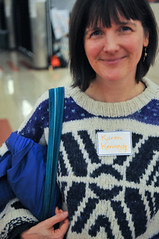


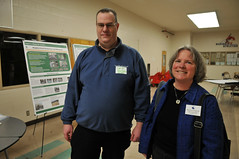

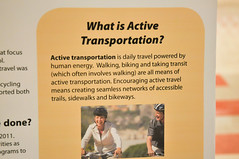
Overall, it was a solid event; although I could have done with fewer speeches (which was mostly preaching to the choir). The main themes that emerged were the High Crash Corridors program, sidewalks and pedestrian safety, Safe Routes to Schools, Neighborhood Greenways, and East Portland and the idea of spreading the benefits of safe and “true choice” transportation beyond Portland’s inner core.
The Summit was also a shining example of the role — and power of — citizen activists in making this city work. PBOT Director Tom Miller put it best when he told the crowd, “We appreciate the citizen activism… That’s how things get done in Portland. We don’t do this alone.”
— See more more photos from the the event in the gallery.




